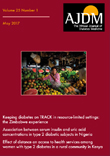Microalbuminuria can occur in patients with diabetes without current or future diabetic nephropathy
*Corresponding Author:
Received: 02-Jan-2023, Manuscript No. ajdm-23-90355; Editor assigned: 04-Jan-2023, Pre QC No. ajdm-23-90355 (PQ); Reviewed: 18-Jan-2023, QC No. ajdm-23-90355 ; Revised: 23-Jan-2023, Manuscript No. ajdm-23-90355 (R); Published: 30-Jan-2023
Introduction
Diabetic Nephropathy (DN) and Diabetic Retinopathy (DR) are considered related diabetic vascular complications because the kidney and retina share similar-sized arteries. In clinical practice, the diagnosis of DR is used as a non-interventional renal biopsy to diagnose DN. Thus, in diabetic patients with a history of DM for at least 5 years and albuminuria with or without decreased eGFR, coexistence of DR raises clinical suspicion that the patient also has her DN. The incidence of diabetic retinopathy varied between studies and is probably related to cohort duration. Micro albuminuria can occur in patients with DM without current or future DN, and in patients without DM but with other types of progressive chronic kidney disease, therefore the presence of DN It does not work as a specific marker. Endothelial dysfunction has been suggested to underlie the renal and/or cardiovascular organ damage seen in these diseases. The steno hypothesis proposed that increased vascular endothelial permeability results in a higher risk of microangiopathy and a propensity for macro vascular disease.
Description
The event that triggers atherogenesis is damage to the endothelium. Due to hemodynamic stress or dyslipidemia, and according to the ‘response to injury’ hypothesis, increased transendothelial permeability of macromolecules is one such type of response. Thus, MA better predicts the development of DN in type 1 DM, whereas MA in type 2 DM serves as a marker of both DN and systemic endothelial dysfunction. Some type 2 DM patients with MA have hypertensive filaments compared with those who do not progress to the overt proteinuria stage and are more likely to progress to develop diabetic glomerulosclerosis. You may be a patient with glomerular sclerosis. Patients with type 2 DM with MA, with or without decreased eGFR, clearly have a long history of hypertension and vascular findings of common atherosclerosis, even though both criteria of DN are present. Longer follow-up for both eGFR and proteinuria may be required before a diagnosis of DN is made. Although micro albuminuria is not necessarily a marker of irreversible renal damage, it is most likely acute renal stress and for this reason regression of MA is not uncommon.
Patients who do not appear to improve MA despite DM control may be individuals with more severe atherosclerosis. Smokers, chronic hypertensives, and patients with long-standing hyperlipidemia in whom MA may reflect systemic vascular endothelial disease. Habitual intake of dietary protein in humans depends on well-known factors that influence GFR, such as age, sex, and lean body mass. Although there are reports suggesting that protein overload may not increase renal protein clearance in healthy individuals, animal models have shown that protein overload increases proteinuria. Eating dietary protein has also been shown in humans to promote chronic kidney disease by increasing glomerular pressure and hyperfiltration, and may be detrimental to CKD patients.
Conclusion
Dietary differences in protein abundance can lead to differences in GFR and albumin clearance, as well as albumin abundance measured in urine samples. Hypoalbuminemia, on the other hand, is a multifactorial process resulting from decreased albumin synthesis and increased degradation, extravasation into the extravascular space, and decreased protein uptake. This systemic transvascular leakage of albumin is associated with clinical atherosclerotic cardiovascular disease. Patients with overt malnutrition, malabsorption syndrome (protein-losing enteropathy), or liver dysfunction and chronic inflammatory conditions may have decreased serum albumin levels due to decreased albumin uptake, absorption, or synthesis.
Acknowledgment
None
Conflict of Interest
The author has nothing to disclose and also state no conflict of interest in the submission of this manuscript.





